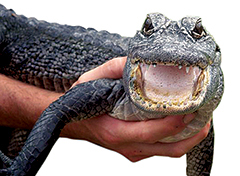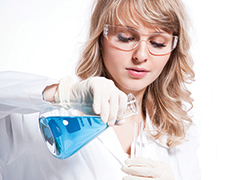Marine Education Center
Coastal Explorer
Page Content

In this unique three-hour field trip program, teachers choose from eight exciting
topics to create their own marine education experience. Field trips are held at our
state-of-the-art facility. Our 100-acre site on Davis Bayou in Ocean Springs, Mississippi,
features indoor and outdoor classrooms, laboratories, nature trails and floating classrooms
in a unique coastal setting. Program fees begin at $15 per participant. Owl Pellet
dissections add $5 lab fee per participant, perch dissections add $10 lab fee each
per participant, shark dissections add $12 lab fee per participant.
Contact us at 228.818.8095 or marine.educationFREEMississippi today to book your trip!
Choose three from the eight marine education modules below to create your custom three-hour field trip.
 Students learn about indigenous turtles, terrapins, alligators, and snakes of South
Mississippi. Students interact with lab specimens and artifacts in the classroom laboratory
and learn how humans impact local wildlife. Educators start with the classification
of reptiles and teach what physical characteristics distinguish crocodiles from alligators
and sea turtles from tortoises. Participants will learn the biology of various reptiles,
including the differences between non-venomous and venomous snakes.
Students learn about indigenous turtles, terrapins, alligators, and snakes of South
Mississippi. Students interact with lab specimens and artifacts in the classroom laboratory
and learn how humans impact local wildlife. Educators start with the classification
of reptiles and teach what physical characteristics distinguish crocodiles from alligators
and sea turtles from tortoises. Participants will learn the biology of various reptiles,
including the differences between non-venomous and venomous snakes. When the MEC team began their journey to create a "best-in-class" marine education
center, professionals surveyed the entire area on Davis Bayou cataloging trees, habitats,
and resident animal populations. The site features tidal marshes, maritime forests,
coastal bayous and a forested Bayhead. Participants venture to the Osprey Point Interpretive
Trail to visit unique habitats, observe varieties of plants, birds, and animals, and
learn about the characteristics that distinguish one habitat from another.
When the MEC team began their journey to create a "best-in-class" marine education
center, professionals surveyed the entire area on Davis Bayou cataloging trees, habitats,
and resident animal populations. The site features tidal marshes, maritime forests,
coastal bayous and a forested Bayhead. Participants venture to the Osprey Point Interpretive
Trail to visit unique habitats, observe varieties of plants, birds, and animals, and
learn about the characteristics that distinguish one habitat from another. Students will collect water samples from Davis Bayou to test various aspects of water
chemistry. In a guided setting, students will apply chemical methods for measuring
salinity, dissolved oxygen, pH, and temperature. Students will learn how water quality
changes with the seasons, how it impacts coastal wildlife, and how scientists monitor
these changes. Educators teach about expanding dead zones, algae blooms and how upstream
chemical runoff and other pollutants impact the water quality in the Mississippi Sound,
the Gulf of Mexico, and beyond.
Students will collect water samples from Davis Bayou to test various aspects of water
chemistry. In a guided setting, students will apply chemical methods for measuring
salinity, dissolved oxygen, pH, and temperature. Students will learn how water quality
changes with the seasons, how it impacts coastal wildlife, and how scientists monitor
these changes. Educators teach about expanding dead zones, algae blooms and how upstream
chemical runoff and other pollutants impact the water quality in the Mississippi Sound,
the Gulf of Mexico, and beyond.  USM researchers are leaders in the field of cultivating copepods that are critical
food sources for newly hatched fish in aquaculture systems. Students begin the session
with a walk to the bayou and pulling a net to collect plankton. Returning to the laboratory
classroom, students examine collected specimens under microscopes, identify zooplankton,
phytoplankton, holoplankton, and meroplankton, and learn the differences between them.
Participants gain an understanding of the importance of plankton in the food web and
how changes in populations can impact the food chain in a coastal environmental system.
USM researchers are leaders in the field of cultivating copepods that are critical
food sources for newly hatched fish in aquaculture systems. Students begin the session
with a walk to the bayou and pulling a net to collect plankton. Returning to the laboratory
classroom, students examine collected specimens under microscopes, identify zooplankton,
phytoplankton, holoplankton, and meroplankton, and learn the differences between them.
Participants gain an understanding of the importance of plankton in the food web and
how changes in populations can impact the food chain in a coastal environmental system.
 Marine educators created a dichotomous key featuring local species to teach about
taxonomy and classification and to help students learn the techniques to distinguish
organisms. Educators demonstrate observation and identification techniques to aid
in the critical thinking process to identify and evaluate morphological differences
of fish, crabs, clams, snails and other organisms to their taxonomic level.
Marine educators created a dichotomous key featuring local species to teach about
taxonomy and classification and to help students learn the techniques to distinguish
organisms. Educators demonstrate observation and identification techniques to aid
in the critical thinking process to identify and evaluate morphological differences
of fish, crabs, clams, snails and other organisms to their taxonomic level. Students engage in a learning adventure studying coastal birds of prey including osprey,
swallow-tailed kite, bald eagles and owls, their nesting and hunting habits and ecological
specialization.
Students engage in a learning adventure studying coastal birds of prey including osprey,
swallow-tailed kite, bald eagles and owls, their nesting and hunting habits and ecological
specialization.Students work in pairs to dissect a preserved owl pellet to understand the unique digestion system of owls and their diet.
 Learn why sharks are apex predators and what our research scientists are learning
in ongoing USM GCRL shark research in the Gulf. Students work in small teams to dissect
a shark specimen to gain an understanding of internal and external shark anatomy.
Marine educators explain the seven senses of sharks, what's unique about their digestive
system, and how they have evolved over millions of years.
Learn why sharks are apex predators and what our research scientists are learning
in ongoing USM GCRL shark research in the Gulf. Students work in small teams to dissect
a shark specimen to gain an understanding of internal and external shark anatomy.
Marine educators explain the seven senses of sharks, what's unique about their digestive
system, and how they have evolved over millions of years. Students work in small groups to dissect a fish specimen to learn first-hand about
internal and external fish anatomy. Educators explore scale type, digestive and respiratory
systems and ecological adaptations such as fin shape and caudle peduncle. Students
remove otoliths (fish ear bones) and learn how fisheries research scientists analyze
the otoliths to chart fish age and growth rates all over the world.
Students work in small groups to dissect a fish specimen to learn first-hand about
internal and external fish anatomy. Educators explore scale type, digestive and respiratory
systems and ecological adaptations such as fin shape and caudle peduncle. Students
remove otoliths (fish ear bones) and learn how fisheries research scientists analyze
the otoliths to chart fish age and growth rates all over the world.